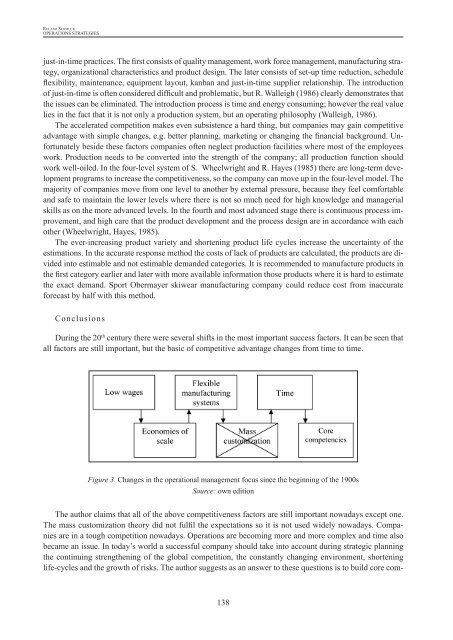regional formation and development studies - KlaipÄdos universitetas
regional formation and development studies - KlaipÄdos universitetas
regional formation and development studies - KlaipÄdos universitetas
You also want an ePaper? Increase the reach of your titles
YUMPU automatically turns print PDFs into web optimized ePapers that Google loves.
Rol<strong>and</strong> Schmuck<br />
OPERATIONS STRATEGIES<br />
just-in-time practices. The first consists of quality management, work force management, manufacturing strategy,<br />
organizational characteristics <strong>and</strong> product design. The later consists of set-up time reduction, schedule<br />
flexibility, maintenance, equipment layout, kanban <strong>and</strong> just-in-time supplier relationship. The introduction<br />
of just-in-time is often considered difficult <strong>and</strong> problematic, but R. Walleigh (1986) clearly demonstrates that<br />
the issues can be eliminated. The introduction process is time <strong>and</strong> energy consuming; however the real value<br />
lies in the fact that it is not only a production system, but an operating philosophy (Walleigh, 1986).<br />
The accelerated competition makes even subsistence a hard thing, but companies may gain competitive<br />
advantage with simple changes, e.g. better planning, marketing or changing the financial background. Unfortunately<br />
beside these factors companies often neglect production facilities where most of the employees<br />
work. Production needs to be converted into the strength of the company; all production function should<br />
work well-oiled. In the four-level system of S. Wheelwright <strong>and</strong> R. Hayes (1985) there are long-term <strong>development</strong><br />
programs to increase the competitiveness, so the company can move up in the four-level model. The<br />
majority of companies move from one level to another by external pressure, because they feel comfortable<br />
<strong>and</strong> safe to maintain the lower levels where there is not so much need for high knowledge <strong>and</strong> managerial<br />
skills as on the more advanced levels. In the fourth <strong>and</strong> most advanced stage there is continuous process improvement,<br />
<strong>and</strong> high care that the product <strong>development</strong> <strong>and</strong> the process design are in accordance with each<br />
other (Wheelwright, Hayes, 1985).<br />
The ever-increasing product variety <strong>and</strong> shortening product life cycles increase the uncertainty of the<br />
estimations. In the accurate response method the costs of lack of products are calculated, the products are divided<br />
into estimable <strong>and</strong> not estimable dem<strong>and</strong>ed categories. It is recommended to manufacture products in<br />
the first category earlier <strong>and</strong> later with more available in<strong>formation</strong> those products where it is hard to estimate<br />
the exact dem<strong>and</strong>. Sport Obermayer skiwear manufacturing company could reduce cost from inaccurate<br />
forecast by half with this method.<br />
Conclusions<br />
During the 20 th century there were several shifts in the most important success factors. It can be seen that<br />
all factors are still important, but the basic of competitive advantage changes from time to time.<br />
Figure 3. Changes in the operational management focus since the beginning of the 1900s<br />
Source: own edition<br />
The author claims that all of the above competitiveness factors are still important nowadays except one.<br />
The mass customization theory did not fulfil the expectations so it is not used widely nowadays. Companies<br />
are in a tough competition nowadays. Operations are becoming more <strong>and</strong> more complex <strong>and</strong> time also<br />
became an issue. In today’s world a successful company should take into account during strategic planning<br />
the continuing strengthening of the global competition, the constantly changing environment, shortening<br />
life-cycles <strong>and</strong> the growth of risks. The author suggests as an answer to these questions is to build core com-<br />
138

















